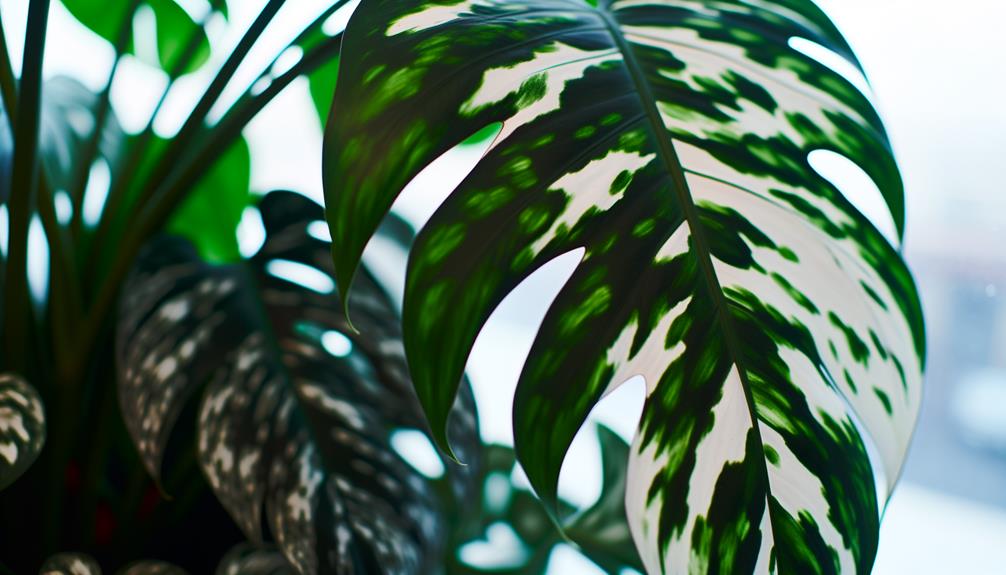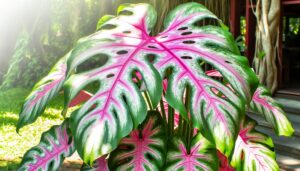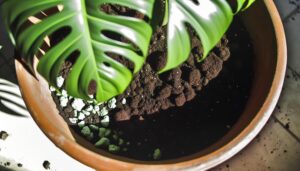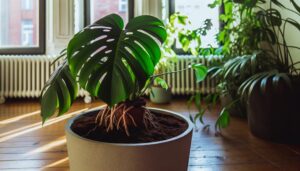Monstera Deliciosa Rubra Albo-Variegata
You're looking at one of the rarest and most enchanting houseplants, the Monstera Deliciosa Rubra Albo-Variegata. Originating from Central America's tropical rainforests, this plant is renowned for its unique variegation caused by genetic mutations.
It features green, white, and occasionally pink or red hues due to anthocyanin pigments. With its large, fenestrated leaves, it requires bright indirect sunlight, high humidity, and consistent moisture without waterlogging.
Due to its slower growth rate and dense structure, it demands careful attention. If you're intrigued by its care and distinct characteristics, there's more to discover.

Key Takeaways
- Originates from tropical rainforests in Central America with a history of cultivation since the 18th century.
- Features unique variegated leaves with green, white, and occasional pink or red pigments due to genetic mutations.
- Requires bright, indirect light, high humidity, and consistent watering for optimal growth.
- Grows slower with denser structures due to reduced chlorophyll and displays enhanced aerial root development.
- Highly sought after for its rarity, aesthetic appeal, and cultural symbolism among plant enthusiasts.
Origins and History
The Monstera Deliciosa Rubra Albo-Variegata, a rare and striking cultivar, originates from the tropical rainforests of Central America where it thrives under the dense canopy. You'll find this plant in countries like Costa Rica and Panama, where it climbs trees with aerial roots, seeking indirect sunlight. Its natural habitat provides humid conditions and dappled light, replicating the understory environment.
Historically, indigenous peoples recognized its large, fenestrated leaves and edible fruit, often called the 'Mexican breadfruit.' Europeans discovered it in the 18th century, leading to its introduction into botanical collections worldwide. Today, this variegated form is particularly prized among collectors and horticulturists for its unique genetic mutation, making conservation and propagation efforts vital.
Unique Characteristics
You'll notice the Monstera Deliciosa Rubra Albo-Variegata possesses distinctive leaf markings characterized by striking white and pink variegation. These rare color variations result from a genetic mutation that affects chlorophyll distribution, creating a unique mosaic pattern.
Additionally, its growth pattern displays differences such as slower vertical extension and more compact leaf arrangements compared to the typical Monstera Deliciosa.
Distinctive Leaf Markings
Among the most striking features of Monstera Deliciosa Rubra Albo-Variegata are its distinctive leaf markings, characterized by irregular patches of creamy white and deep green variegation. These unique patterns result from a natural mutation affecting chlorophyll distribution, leading to a mesmerizing mosaic effect.
To understand these markings, consider the following:
- Chlorophyll Deficiency: The creamy white regions lack chlorophyll, resulting in reduced photosynthetic capability.
- Genetic Mosaicism: The variegation patterns are due to genetic mosaicism, where different cells express different genetic material.
- Sectorial Variants: The variegation can appear in sectors, patches, or even streaks, making each leaf entirely unique.
Rare Color Variations
Beyond their distinctive leaf markings, Monstera Deliciosa Rubra Albo-Variegata occasionally exhibits rare color variations, such as hints of pink or red, resulting from anthocyanin pigments interacting with the plant's unique variegation.
These pigments, typically responsible for red, purple, and blue hues in plants, can be influenced by factors like light intensity and nutrient availability. When the anthocyanins appear, they create a striking contrast against the white and green variegated sections, enhancing the plant's visual appeal.
The presence of these colors can indicate a healthy pigment synthesis process and ideal growing conditions. Monitoring these variations can offer insights into the plant's physiological responses and overall health, making them a fascinating subject for both hobbyists and botanists.
Growth Pattern Differences
Examining the growth patterns of Monstera Deliciosa Rubra Albo-Variegata reveals unique characteristics that distinguish it from other variegated varieties. You'll notice that this cultivar exhibits slower growth rates due to the reduced chlorophyll in its variegated leaves, impacting photosynthesis efficiency.
The internodal spacing tends to be shorter, leading to a more compact appearance. Additionally, the aerial roots are often more prominent, aiding in nutrient absorption and support.
Consider the following key points:
- Chlorophyll Deficiency: Reduced chlorophyll causes slower overall growth.
- Internodal Spacing: Shorter internodal spacing results in a denser plant structure.
- Aerial Roots: Enhanced development of aerial roots provides better nutrient uptake and stability.
Understanding these growth patterns will help you provide ideal care for this rare and beautiful plant.
Ideal Growing Conditions
Ensuring top growth for Monstera Deliciosa Rubra Albo-Variegata requires maintaining specific light, temperature, and humidity conditions.
You'll need to provide bright, indirect light; direct sunlight can scorch the variegated leaves.
Best temperatures range between 65-80°F (18-27°C), avoiding sudden temperature fluctuations.
Humidity should be kept high, around 60-80%, to mimic their tropical origins. You can achieve this by using a humidifier or placing the plant on a humidity tray.
Additionally, good air circulation is essential to prevent fungal infections. Make sure your Monstera isn't exposed to cold drafts or dry air from heating vents.
Watering and Feeding
For Monstera Deliciosa Rubra Albo-Variegata, you'll need to maintain a suitable watering schedule to prevent root rot while ensuring adequate hydration. Utilize nutrient-rich soil to support its variegated foliage and overall health.
Additionally, adjust your feeding regimen seasonally to match the plant's growth cycle and metabolic demands.
Optimal Water Schedule
To maintain the health and vibrant variegation of your Monstera Deliciosa Rubra Albo-Variegata, water it thoroughly when the top 2 inches of soil are dry, making sure even moisture distribution without waterlogging the roots. Consistent hydration is essential, as fluctuations can cause stress, leading to diminished variegation and potential root rot. Use distilled or rainwater to avoid mineral buildup.
Consider these guidelines:
- Check soil moisture levels: Insert a moisture meter or your finger to a 2-inch depth.
- Water evenly: Pour slowly around the plant's base, allowing water to reach all root zones.
- Drainage: Guarantee pots have drainage holes to prevent stagnant water, which can lead to root issues.
Adhering to these practices will keep your plant thriving.
Nutrient-Rich Soil Needs
Providing nutrient-rich soil ensures your Monstera Deliciosa Rubra Albo-Variegata receives the essential minerals and organic matter necessary for ideal growth and vibrant variegation. You should use a well-draining potting mix that includes components like peat moss, perlite, and orchid bark. These ingredients enhance aeration and prevent waterlogged roots, which can lead to root rot.
Incorporate slow-release fertilizers rich in nitrogen, phosphorus, and potassium to support robust foliage and root development. Regularly check soil pH, maintaining a slightly acidic range of 5.5 to 6.5. Proper watering practices complement nutrient absorption; water thoroughly when the top inch of soil is dry, ensuring even moisture distribution. Avoid overwatering, as excessive moisture can leach nutrients away from the root zone.
Seasonal Feeding Tips
During the growing season, make sure your Monstera Deliciosa Rubra Albo-Variegata receives balanced feedings and appropriate watering to sustain its vibrant variegation and vigorous growth. Utilize a water-soluble, balanced fertilizer (20-20-20) every 4-6 weeks to provide essential macronutrients. Maintain consistent soil moisture without waterlogging to promote peak root health.
For enhanced understanding, consider the following tips:
- Fertilizer Application: Dilute to half strength; over-fertilization can result in leaf burn and root damage.
- Watering Frequency: Adjust based on ambient humidity and temperature; typically, water when the top 2 inches of soil are dry.
- Seasonal Adjustments: Increase feeding during spring and summer; reduce in autumn and winter when growth slows.
Common Issues and Solutions
When cultivating Monstera Deliciosa Rubra Albo-Variegata, how do you address common issues such as root rot, leaf browning, and insufficient variegation?
For root rot, ensure proper aeration and drainage by utilizing a well-draining soil mix. Avoid overwatering; allow the top inch of soil to dry before watering again.
Leaf browning often results from low humidity or direct sunlight. Increase humidity using a humidifier and place the plant in bright, indirect light.
Insufficient variegation can be due to inadequate light. Provide at least 6-8 hours of indirect sunlight or use grow lights.
Regularly inspect for pests like spider mites, which can worsen these issues. By addressing these factors, you'll maintain a healthy and vibrant Monstera Deliciosa.
Popularity and Cult Following
The Monstera Deliciosa Rubra Albo-Variegata has garnered a significant cult following due to its striking variegation and rarity, making it a coveted specimen among plant enthusiasts and collectors. This cultivar's unique coloration results from a genetic mutation that produces a mosaic of green, white, and red pigments, enhancing its ornamental value. Its allure is further amplified by its limited availability and intricate care requirements.
To understand its popularity, consider the following:
- Aesthetic Appeal: The contrasting variegation provides a visually stunning display.
- Rarity: The plant's scarcity drives demand and elevates its status among collectors.
- Cultural Symbolism: Owning such a rare plant signifies dedication and expertise in horticulture.
Conclusion
Caring for a Monstera deliciosa rubra albo-variegata is like tending to a rare, mythical creature. It demands precise humidity, meticulous watering, and balanced feeding, just as a dragon requires specific treasures to thrive.
By understanding its unique variegation, you become a guardian of its botanical secrets. In mastering these skills, you join a dedicated cult following, bound by the shared reverence for this living masterpiece.
Your care guarantees it remains an enchanting marvel in your plant collection.






